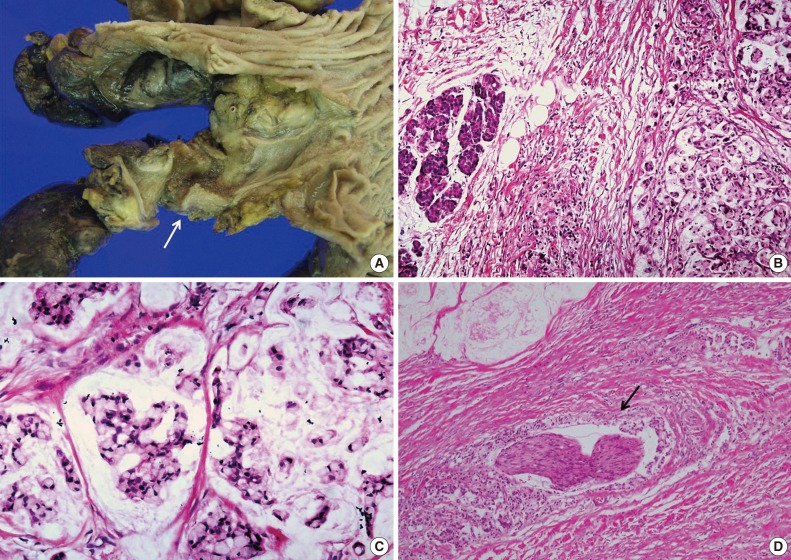Signet-Ring Cell Carcinoma of the Distal Common Bile Duct: Report of a Case
Article information
Signet-ring cell carcinoma (SRCC) of the extrahepatic bile duct is a histologically distinct entity classified by the World Health Organization, in which cells containing intracytoplasmic mucin displacing the nucleus predominate.1 SRCC of the gastrointestinal tract is most commonly found in the stomach, and the impact of this histology on the prognosis is controversial.2,3
Well to moderately differentiated adenocarcinoma is the most common histologic type and complete resection is the only potentially curative therapy for distal bile duct cancer.4 However SRCC of extrahepatic bile duct is extremely rare, so its clinico-pathological features and impact on the prognosis are not well known. To the best of our knowledge, only three cases of SRCC of the extrahepatic bile duct have been reported in the English literature.5,6,7 Herein, we present a case of SRCC originating from the epithelium of the distal extrahepatic bile duct.
CASE REPORT
A 63-year-old man presented with a 2-week history of epigastric pain and jaundice. His past medical history was unremarkable. Total bilirubin concentration was 9.3 mg/dL, alkaline phosphatase level was 290 IU/L (normal range, 115 to 359 IU/L), carcinoembryonic antigen was 1.1 ng/mL (normal range, 0 to 7 ng/mL), and cancer antigen 19-9 was 3.9 U/mL (normal range, 0 to 37 U/mL). Abdominal computed tomography (CT) showed wall thickening and luminal narrowing at the distal common bile duct (CBD) with proximal intrahepatic duct dilatation (Fig. 1A). Gastroduodenal fiberscopy revealed normal gastric and duodenal mucosa except a prominent ampulla, and biopsy of the ampulla showed inflammatory change. Endoscopic retrograde cholangiogram showed complete obstruction due to polypoid mass at the distal CBD and preoperative endoscopic bile drainage was performed (Fig. 1B). Upon clinical implication of carcinoma arising at the distal CBD, a pylorus-preserving pancreatoduodenectomy was performed.

Abdominal computed tomography and cholangiogram. (A) Coronal image of abdominal computed tomography shows complete obstruction of the bile duct due to the thickening of the bile duct wall (arrow). (B) Endoscopic retrograde cholangiogram shows complete obstruction at the distal common bile duct.
The surgically-removed specimen showed that the ulcerofungating tumor at the distal CBD with the size of 1.5 cm in diameter (Fig. 2A). A microscopic examination of the tumor revealed diffusely infiltrative tumor cells invading into the capsule of the pancreas (Fig. 2B). The tumor cells contained abundant intracytoplasmic mucin, which pressed the nuclei toward the periphery of the tumor cells (Fig. 2C). Focal production of the mucin pool was identified, but it did not exceed 50% of the tumor. Some of the tumor cells consisted of poorly formed glandular structures, but even the tumor cells forming glands retained the same cytologic features with individually infiltrative signet-ring cells. At the interface between tumor and adjacent normal mucosa, no preneoplastic change was identified. Numerous lymphatic emboli and a few foci of perineural invasion were observed (Fig. 2D). Lymph node metastasis was not present in any of the nine submitted lymph nodes and all resection margins were free of carcinoma. TNM staging of the tumor was pT3N0M0, stage IIA according to the seventh edition of the American Joint Committee on Cancer (AJCC) cancer staging system.

Macroscopic and microscopic findings of the tumor at the distal common bile duct. (A) An ulcerofungating tumor identified at the distal common bile duct (arrow). (B) Carcinoma invaded into the capsule of the pancreas. At high-power field, microscopic examination of the tumor reveal a signet-ring cell carcinoma comprising more than 50% of the tumor tissue (C), and a few perineural invasion are present (D, arrow).
The patient's recovery was uneventful. The patient was regularly followed up. Five months after surgery, lymph node metastasis around the paraaortic area was found on abdominal CT, but the patient did not want to have chemotherapy. He died 15 months after surgery due to multiple distant metastases.
DISCUSSION
Several cases of SRCC originating from the biliary epithelium including the ampulla of Vater, gallbladder and intrahepatic bile duct have been reported,8,9 but SRCC of the extrahepatic bile duct is extremely unusual. To the best of our knowledge, only three cases of SRCC of the extrahepatic bile duct including two Japanese and one Korean patient have been reported in the English literature.5,6,7 Clinicopathologic features of reported SRCC cases arising in the extrahepatic bile duct are summarized in Table 1. Interestingly, all four patients were Asians, but their age and follow-up data were variable.
Because this type of variant is extremely rare in sites other than the stomach, SRCC of gastric origin should be excluded, once it is found in another site. In the present case, gastroduodenal fiberscopy revealed no mucosal lesion in the stomach, duodenum, or peri-ampullary region. Thus, it is unlikely that the tumor is a metastatic lesion.
Although periampullary tumors require the same surgical approach, the prognosis of the tumor differs according to its origin. Tumors with a biliary epithelial origin are known to have a better prognosis than those with a duodenal or pancreatic ductal epithelial origin.10 Although the present case originated clearly from the bile duct, the patient developed lymph node metastasis around the paraaortic area at 5 months after surgery and died at 15 months after surgery. The poor prognosis may be related with presence of perineural invasion and lymphatic invasion. It is unclear whether the prognosis of SRCC of the extrahepatic bile duct is worse than that of ordinary type carcinoma at the same stage, because only rare cases of this variant have been reported. The impact of signet-ring cell type histology on the prognosis of extrahepatic bile duct carcinoma may be determined through additional reports of this unusual variant.
Notes
No potential conflict of interest relevant to this article was reported.
